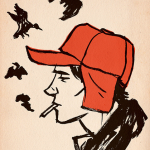High-brow Cultural Vegetable of the Week: Gulliver’s Travels
Vegetable Equivalent: Broccoli, a vegetable forced upon you as a child but returned to with enthusiasm as an adult
Nutritional Value: Improved eyesight; greater awareness of proportion
Recommended Serving Size: Parts One and Four and a refusal to accept the 2010 Jack Black-vehicle adaptation as a substitute
Great satire makes unfamiliar the things we take for granted. Properly deployed, satire forces us to be both the observer and the observed, to see what’s wrong not only with the world but with ourselves.
Gulliver, the hapless protagonist and narrator of Jonathan Swift’s hilarious 18th Century satire, encounters four alien islands during his titular travels. The contrast between where Gulliver starts and ends up is so great that he doesn’t have to try to defamiliarize the world. That’s done for him. In Part 1, he encounters a race of six-inch tall humans: the Lilliputians. In Part 2, he finds himself on the island of the Brobdingnagians, giants twelve times his own size. By Part 4, he finds himself on an island where the civilized animals are horses (the Houyhnhnms) and the brutish animals are men (the Yahoos). In each location, he learns about how these people eat, educate their children, punish crime, and attain happiness.
Gulliver offers a first-person account of his travels, but we rely on him more for his descriptions than his commentary. Swift constantly underscores his interest in perspective by showing us things about Gulliver that Gulliver is completely oblivious to. Two examples from the Lilliputian voyage will suffice. Gulliver discovers that the Lilliputians have fought a religious civil war over whether an egg should be cracked at the big or little end. Gulliver doesn’t seem to make the connection between these diminutive creatures and their equally petty quibbles, but the audience immediately sees the critique: humans shed blood over stupid things. Elsewhere, the Lilliputians describe Gulliver’s belongings to their king, paying special attention to a “wonderful kind of engine” which “is either some unknown animal or the god that [Gulliver] worships.” They are talking about Gulliver’s watch, an item which Gulliver constantly consults. Thus, the Lilliputians expose a mundane, thoroughly routinized human behavior as a religious observance, something Gulliver never could or would notice about himself.
The satirical target travels back and forth between the strange creatures Gulliver encounters and Gulliver himself. As a result, we as readers can’t get comfortable. We don’t know when we’re supposed to judge or when our laughter will suddenly be held against us. The targets are occasionally easy, but Swift makes sure that there are just as many that expose Gulliver’s — and our — errant aim. We look down to realize that we’re the ones with bulls-eyes on our chest.
By the time Gulliver lands on the island of the Houyhnhnms, he has thoroughly internalized a cynical view of humanity, swapping rose-colored glasses for misanthropic contacts. The irony is that Gulliver runs not from the corruption of England but from himself and his own emptiness. He is a cipher, a hollow container to be filled with the views of whatever culture he visits. When on his final voyage, he encounters a creature most like himself — the Yahoos of Part 4 — he is so disgusted at their behavior and appearance that he wants them eradicated.
Swift’s final satirical jab is at satire itself, a radical skepticism that maintains nothing and critiques everything. Here, it’s not just the reader who is on trial; it’s the author. In this final voyage, Swift shows us his hands smeared black with the ink of his own poison pen.











